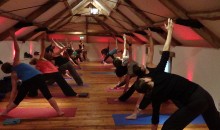Yoga for Autumn- warming, nourishing, grounding
September 17, 2013

Beutiful yoga studio at Pennard House
Dr David Frawley writes: “Half of Ayurvedic treatment is what goes into the body, which is mainly food. The other half is what the body does by way of expression, which is mainly exercise. Asana deals with this.” Asanas reflect an amazing understanding of how the body works and how to release tension at a deep level from tissues, organs and joints.
Yogis need to consider not only their Ayurvedic Doshic constitutions/imbalance but also age, season and times of day for an Ayurvedic yoga practice. For example, during sunrise and sunset, vata is most stimulated and so calming, grounding asanas are best at these times. After 6:00am is Kapha time and a more stimulating practice is better. It is important to note that whilst some asanas are better for some types than others, we need to do all the major asanas for full health, just as we need all 6 Ayurvedic tastes in a meal. A full practice should include sitting, standing, lying, expansive, contractive, ascending, descending movements. Mukunda Stiles also reminds us, “Regardless of which doshas is imbalanced, balancing Vata and returning the pranas to their home region and function can rectify all other doshas… all students need to have a Sadhana that begins and concludes with Vata balancing.”
Autumn is predominantly a cool, dry, windy season when Vata dosha dominates, both inside and outside our bodies. Vata is predominant in the elements air and space, giving it cold, light, dry, subtle, rough, and mobile qualities. The following asanas are all either grounding, warming and calming so are all good for Vata types, those with aggravated Vata and all feeling the effects of Autumn and the colder weather setting in:
- Sitting poses: Virasana (Hero), Siddhasana (Cross legged with the toes tucked in, Padmasana (Lotus), Vajrasana (Thunderbolt), Lion pose (Simhasana)- help increase calm and groundedness and keep busy types still
- Surya Namaskar (Sun Salutes): Done slowly and consciously – 5 rounds or so.
- Standing poses: Tadasana (Mountain) Vrkasana (tree), Trikonasana (Triangle), Virabhadrasana 1 and 2 (Warrior), Parighasana (Gate) all help ground body and mind, reducing anxiety and nervousness.
- Inversions: Sirshasana (Headstand) or resting with your legs up against the Wall
- Forward bends give immediate relief for excess Vata, and good for tight lower backs and stiff spines especially head to knee pose, Uttanasana (standing forward bend), Paschimottananasana (full forward bend- easier than standing version if back is sore), Vajrasana (child’s pose) which compress the pelvis and Vata region, excellent for constipation and gas. Also for insomnia- practice a 10 minute forward bend before bed time
- Back bends: Done carefully and combined with forward bends, Bhujangasana (Cobra), Salabhasana (locust), Supta Virasana (supine backbend) and Dhanurasana (bow pose).
- Spinal twists: Especially lying and seated to remove Vata from the nervous system. Ensure the breath is as full as possible for the full effects to be felt
- Savasana– at least 20 minutes, with a warm blanket and maybe an eye pillow. It is very important not to just rush off! Yoga nidra (‘psychic sleep’) is also very beneficial (CD’s easy to obtain for this deeply relaxing practice)
To help tailor your yoga practice for Autumn, and make it calming, warming, strengthening, consistent, grounding try some of the following in your practice:
- Practice at a slow, smooth and steady pace with a thorough warm up to prevent injury (Vata predominance or aggravation can make the body stiff and more prone to injury). One way to do this is to imagine you are moving through warm water as you move. Also avoid overstretching as Vata types can also be very flexible
- Keep the breath deep and calm. Ujjayi (Victory breath) is an effective means to achieving this, and it also has the benefit of being a warming breath.
- Explore fluidity in the poses, using gentle movements, rotation in the joints, and movement in the spine. Hold each posture for a short amount of time (5 breaths or so), but do multiple repetitions to get the full benefit of the asanas.
- Focus on the foundation of the pose for stability, grounding through big toes, and the sides of the feet so you feel fully grounded.
- Don’t over do it! Vata types can exhaust themselves- make your practice strengthening, not draining. With aggravated Vata a restorative practice is best.
The following books are recommended for more detail on tailoring yoga according to Ayurvedic wisdom:
1. Ayurvedic Yoga Therapy, Mukunda Stiles (2007)
2. Yoga and Ayurveda, D Frawley (1999)
3. Yoga for Your Type: An Ayurvedic Approach to Your Asana Practice, D Frawley, S Kozak (2001)
